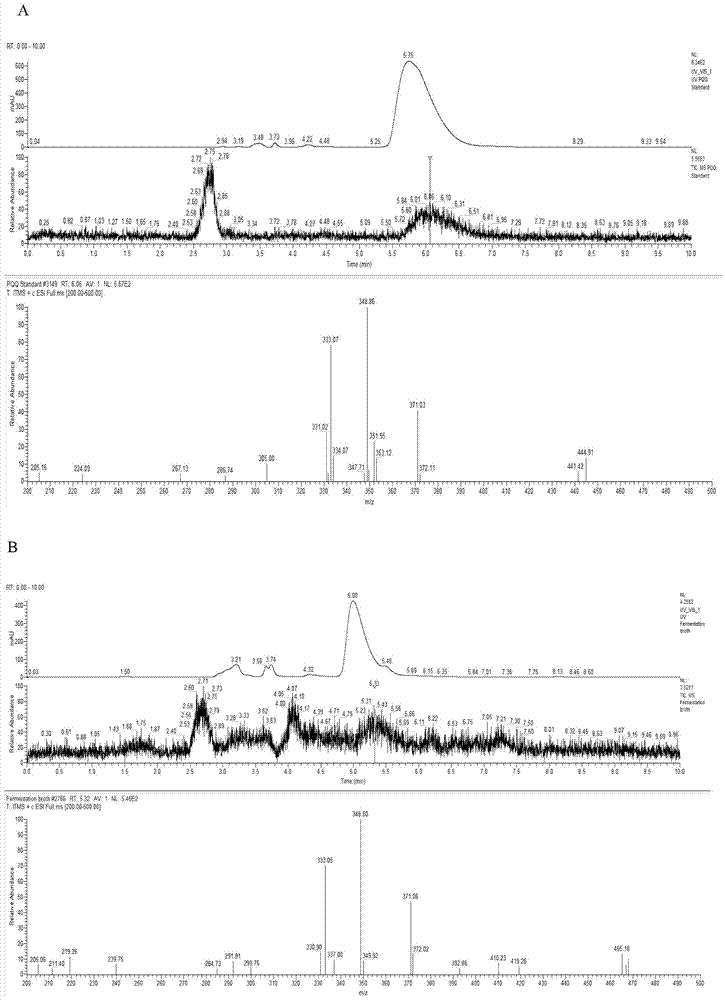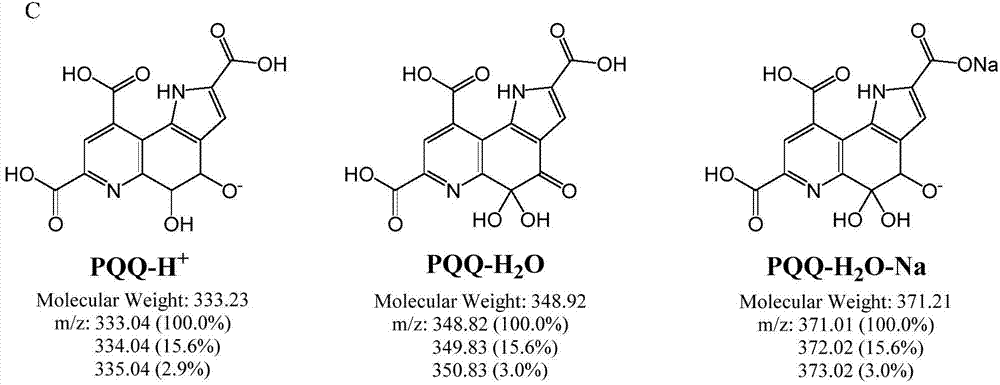Pyrroloquinoline-quinone-producing Hyphomicrobium strain and application thereof
A technology of pyrroloquinoline quinone and filamentous microbe, which is applied in the directions of bacteria, microorganisms, microorganisms, etc., can solve problems such as yield decline, and achieve the effect of stable fermentation performance and favorable purification.
- Summary
- Abstract
- Description
- Claims
- Application Information
AI Technical Summary
Problems solved by technology
Method used
Image
Examples
Embodiment 1
[0062] The composition of the fermentation medium in embodiment 1: methanol 20g / L, ammonium sulfate 2g / L, potassium dihydrogen phosphate 1.2g / L, disodium hydrogen phosphate 4g / L, magnesium sulfate 1g / L, trace element solution 1mL / L L. Vitamin auxiliary solution 2mL / L, the balance is distilled water, pH 6.8.
[0063] Embodiment 1, the screening of pyrroloquinoline quinone producing bacteria
[0064] 1. The chemical sewage water samples collected from Quangang Petrochemical Zone, Quanzhou City were cultured with enrichment medium at 30°C for 48 hours to obtain a culture solution, which was diluted and spread on a screening medium plate, and a single colony (methyl After vegetative bacteria), single colonies were picked and inoculated in the fermentation medium, 30°C, 220r / min shaking culture for 96h, and the growth of the bacteria was observed. Among the more than 120 isolates of methylotrophs, 47 strains could change the color of the screening medium (red, brown or yellow).
...
Embodiment 2
[0079] Embodiment 2, identification of bacterial strain FJNU-R8
[0080] 1. According to "Bergey's Handbook of Systematic Bacteriology" (Second Edition, 2004), the numbered FJNU-R8 strain obtained by screening in Example 1 was identified for its morphological characteristics and physiological and biochemical characteristics. The results are shown in Table 2.
[0081] FJNU-R8 strain is aerobic, Gram-negative, suitable growth temperature is 25-32°C, suitable growth pH is 6.0-8.0; can utilize arabinose, sucrose, xylose, fructose, trehalose and raffinose, but cannot Alcohols such as mannitol, arabitol, and inositol, and cannot utilize amino acids such as ornithine, arginine, and lysine; positive for oxidase, negative for urease and tryptophan deaminase; methyl red, V-P, and starch The hydrolysis test is negative; it can reduce nitrite without producing indole and hydrogen sulfide; it has no fluorescence reaction.
[0082] 2. The colonies of the FJNU-R8 strain are small, round, regu...
Embodiment 3
[0090] Embodiment 3, the influence of culture time on pyrroloquinoline quinone output
[0091] One, pick the FJNU-R8 single bacterium colony of embodiment 2 in the Erlenmeyer flask that 30mL of the seed medium shown in A below is housed, 30 ℃, 220rpm shaking culture 24-36 hour (OD 650 Between 2.5-3.0, adjust to zero with the seed medium) to obtain the seed solution; then transfer the inoculum of 5% of the seed solution by volume to a 250mL Erlenmeyer flask equipped with 50mL of the fermentation medium shown in B below in 30°C, 150-220rpm (Day 0-2: 220rpm; Day 2-6: 150rpm) for 5-6 days to obtain a fermentation broth, which was taken every 8 hours from the start of the transfer, Determination of the biomass of the fermentation broth (OD 650 , adjusted to zero with the fermentation medium shown in B), and the fermentation broth was centrifuged at 10000 × g for 10 min, and the supernatant was taken to measure the pyrroloquinoline quinone (PQQ) yield, methanol and protein content ...
PUM
 Login to View More
Login to View More Abstract
Description
Claims
Application Information
 Login to View More
Login to View More - R&D
- Intellectual Property
- Life Sciences
- Materials
- Tech Scout
- Unparalleled Data Quality
- Higher Quality Content
- 60% Fewer Hallucinations
Browse by: Latest US Patents, China's latest patents, Technical Efficacy Thesaurus, Application Domain, Technology Topic, Popular Technical Reports.
© 2025 PatSnap. All rights reserved.Legal|Privacy policy|Modern Slavery Act Transparency Statement|Sitemap|About US| Contact US: help@patsnap.com



